Click on images to enlarge

infestation (Photo: Sheldon Navie)
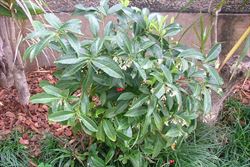
habit in flower (Photo: Sheldon Navie)
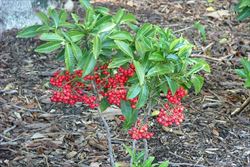
habit in fruit (Photo: Sheldon Navie)
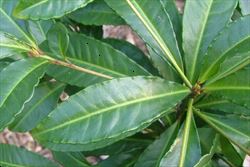
leaves (Photo: Sheldon Navie)

flower buds (Photo: Sheldon Navie)

close-up of flowers showing tiny black spots (Photo: Sheldon Navie)
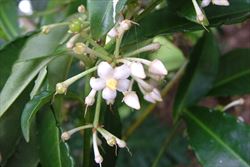
flowers and immature fruit (Photo: Sheldon Navie)
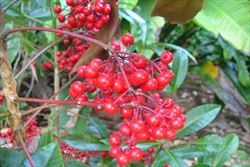
clusters of mature fruit (Photo: Sheldon Navie)
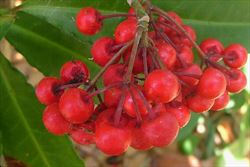
close-up of mature fruit (Photo: Sheldon Navie)
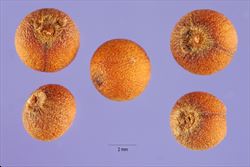
close-up of seeds (Photo: Steve Hurst at USDA PLANTS Database)
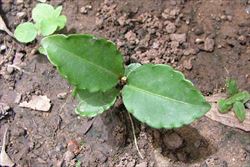
seedling (Photo: Sheldon Navie)
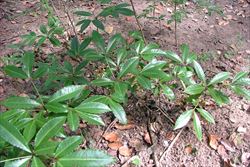
infestation in rainforest understorey at Fig Tree Pocket in Brisbane (Photo: Sheldon Navie)
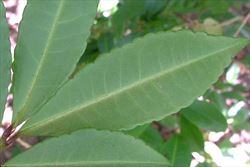
close-up of paler and duller leaf undersides (Photo: Sheldon Navie)
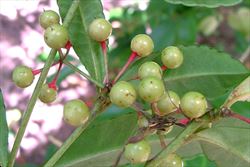
close-up of immature fruit (Photo: Sheldon Navie)

close-up of mature fruit (Photo: Sheldon Navie)
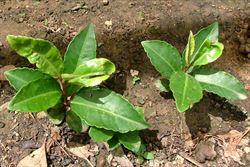
young plants (Photo: Sheldon Navie)

Ardisia crenata 'Alba' (Photo: Sheldon Navie)
Scientific Name
Ardisia crenata Sims
Synonyms
Ardisia crenulata G. Lodd.Ardisia crispa (Thunb.) DC. (misapplied)
Family
Myrsinaceae
Common Names
Australian holly, Christmas berry, coral ardisia, coral berry, coralberry, coral bush, hen's eyes, Hilo holly, scratchthroat, spiceberry
Origin
Native to southern and eastern Asia (i.e. in south-western India, Myanmar, Thailand, Vietnam, Malaysia, the Philippines, China, Korea, Taiwan and Japan).
Cultivation
Widely cultivated as a garden ornamental for its brightly coloured fruit, particularly in the warmer parts of Australia. Several cultivars of this species, with fruit of various colours, have also been developed for use as garden ornamentals. The most common of these are Ardisia crenata 'Alba', which has white mature fruit, and Ardisia crenata 'Pink Pearls', which has bright pink mature fruit.
Naturalised Distribution
Naturalised in the coastal districts of eastern Queensland, in north-eastern New South Wales and in the Sydney area.
Overseas, coral berry (Ardisia crenata) has also become naturalised in southern Africa, south-eastern USA (i.e. Florida and Louisiana), the Mascarenes, the Seychelles and Hawaii.
Habitat
This species prefers rich, well-drained, soils in partially shaded positions (e.g. in closed forests, near forest margins and along waterways). It is a weed of tropical, sub-tropical and warmer temperate regions.
Habit
A small upright (i.e. erect) shrub usually growing up to 1 m tall, but occasionally reaching 2 m in height.
Distinguishing Features
- a small upright evergreen shrub with glossy dark green leaves.
- its alternately arranged leaves are relatively thick and have finely toothed margins.
- its fragrant flowers are white to deep pink in colour and are usually covered in numerous minute black spots.
- its showy bright red berries, which hang down in clusters, can remain on the plant for months.
Stems and Leaves
The stems are usually only branched in the upper part of the plant. The younger branches are rounded (3-4 mm thick) and green in colour. Stems and leaves are generally hairless (i.e. glabrous) throughout.
The simple leaves (5-20 cm long and 1-4 cm wide) are alternately arranged and dark green in colour. They are relatively thick and leathery in nature and narrowly oval or elongated in shape (i.e. elliptic-lanceolate or oblanceolate). These leaves are glossy and dark green above with paler and duller undersides and have slightly toothed (i.e. crenulate) or finely wavy (i.e. undulate) margins. They are borne on short stalks (i.e. petioles) about 3-10 mm long and have pointed tips (i.e. acute to acuminate apices). Each leaf has a central vein with 12-18 pairs of side veins (i.e. lateral nerves), which are slightly raised on the lower surface and merge into a distinct vein along the leaf margin (i.e. a marginal nerve).
Flowers and Fruit
The flowers are small, white to reddish-pink in colour, and fragrant. They are borne in clusters on flowering branches 4-16 cm long. These flowering branches usually divide into several smaller branches (i.e. rays) 2-4 cm long, each of which bear numerous flowers on stalks (i.e. pedicels) 5-10 mm long, which elongate further when in fruit. The flowers (4-6 mm across) usually have five small sepals (1-2.5 mm long) with rounded tips (i.e. obtuse apices), five petals, and five stamens. The five white, or occasionally pinkish, petals (about 4 mm long) are slightly joined together at the base and have pointed tips (i.e. acute apices). Under close inspection, numerous tiny black spots can be seen on the flowers when they are young (i.e they are black punctate).
The flowers are followed by showy bright to dark red 'berries' (actually drupes) that can remain on the plant for several months. These fruit are initially green in colour but turn various shades of red as they mature. They are rounded (i.e. globose) in shape, glossy in appearance, and 5-8 mm across.
Reproduction and Dispersal
This species reproduces by seed. The seeds may be spread by humans (i.e. in dumped garden waste), birds (i.e. which disperse the seed after consuming the attractive fruit), and by water movement (i.e. during floods).
Environmental Impact
Coral berry (Ardisia crenata) is regarded as an environmental weed in New South Wales and Queensland and as a "sleeper weed" in other parts of northern Australia. In Queensland, it is an emerging species in the south-eastern parts of the state and is also causing concern in tropical northern regions. It is on the list of environmental weeds for the Gold Coast and has been reported from bushland near urban areas in this region, particularly near Currumbin Creek. In the Brisbane area it is established in densely forested riparian zones (e.g. along Enoggera Creek) and it is also on the undesirable plant list for Noosa Shire, on the Sunshine Coast. Coral berry (Ardisia crenata) is also naturalised in remnant rainforests in north-eastern New South Wales (e.g. near Mullumbimby) and has been recorded from bushland in the Sydney area. It is particularly invasive in rainforests and other closed forests, largely because its seeds will germinate in low light conditions under a dense forest canopy.
In Florida, in the USA, it was first noted to be escaping into moist forests in 1982. It is now naturalised in hardwood hammocks across several areas in northern Florida and has also become naturalised in Texas. In these regions it has been observed to dominate the forest understorey, often in conservation reserves, and may reach densities of greater than 100 plants per m2 . The native plant diversity is substantially reduced by the presence of this weed, regardless of its density or the site history, and it can also reduce the light levels reaching the forest floor by up to 70%, potentially shading out seedlings and preventing the regeneration of native plants. Mature plants are usually surrounded by a carpet of seedlings, which also displace small native groundcovers such as violets (Viola spp.) and wakerobins (Trillium spp.).
Other Impacts
The fruit of this species are thought to be poisonous to humans.
Legislation
Not declared or considered noxious by any state government authorities.
Similar Species
Coral berry (Ardisia crenata) is relatively similar to shoebutton ardisia (Ardisia elliptica). These two species can be distinguished by the following differences:
- coral berry (Ardisia crenata) has leaves with slightly toothed (i.e. crenulate) and wavy (i.e. undulate) margins. Its fruit usually turn bright or dark red when fully mature.
- shoebutton ardisia (Ardisia elliptica) has leaves with entire margins. Its fruit turn black or purplish-black when fully mature.
There are also several native ardisia species (Ardisia spp.) present in the rainforests of northern Australia.

